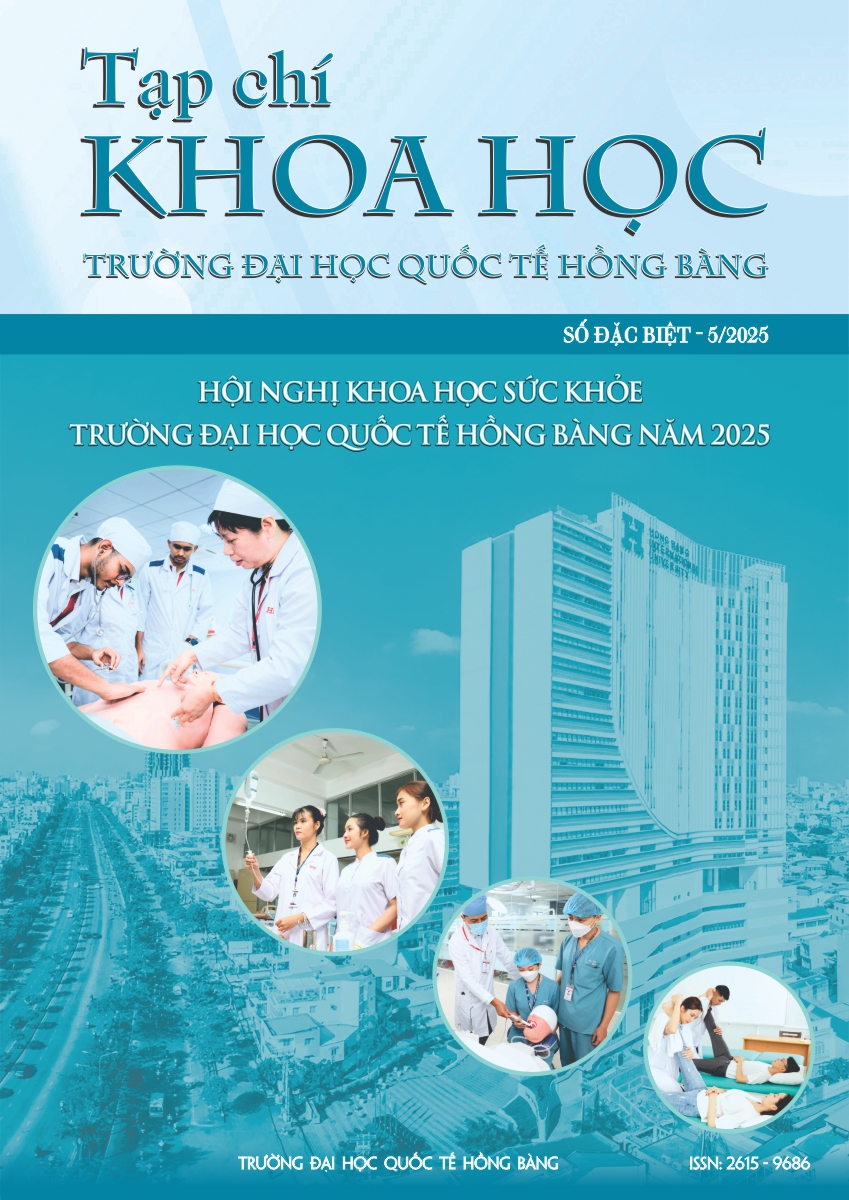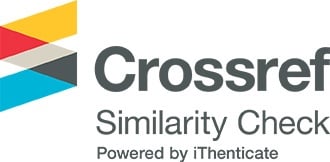NGHIÊN CỨU MÀNG HYDROGEL CHỨA KEO ONG ĐỊNH HƯỚNG GIÚP LÀM LÀNH VẾT THƯƠNG TRÊN DA
Các tác giả
DOI: https://doi.org/10.59294/HIUJS.KHSK.2025.025Từ khóa:
keo ong Brazil, màng hydrogel HPMC, chống oxy hóa, chống viêm, kháng khuẩnTóm tắt
Bối cảnh: Keo ong, chất giúp bảo vệ tổ ong, còn được biết đến với các đặc tính chống viêm, chống oxy hóa và kháng khuẩn. Tuy nhiên, sự kết hợp giữa keo ong và màng hydrogel để giúp làm lành vết thương vẫn chưa được chú trọng nghiên cứu tại Việt Nam. Phương pháp: Điều chế miếng dán hydrogel chứa keo ong 1902 đã được khảo sát các đặc điểm lý hóa, hàm lượng acid phenolic và flavonoid, hoạt tính chống oxy hóa và tính kháng viêm. Miếng hydrogel keo ong sau đó được xác định các đặc tính lý hóa, tính kích ứng trên da và tính kháng khuẩn trên 4 chủng vi khuẩn. Kết quả: Mẫu keo ong 1902 có hàm lượng phenolic acid 111.05 mg/g, khả năng chống oxy hóa IC50 = 766 µg/mL và khả năng chống viêm PI50 = 581.5 µg/mL. Hydrogel keo ong 8% và hydrogel keo ong 10% không gây kích ứng da ở thỏ và có tính kháng khuẩn mạnh nhất đối với E. coli, P. aeruginosa, MRSA và MSSA. Độ ẩm của hydrogel keo ong dao động từ 12.84% đến 13.41%. Kết luận: Màng hydrogel chứa keo ong 10% không gây kích ứng da ở thỏ, có tính kháng khuẩn, chống oxy hóa và chống viêm tối ưu, được định hướng sử dụng nhanh làm lành vết thương trên da.
Abstract
Background: Propolis, a substance that helps protect the honeycomb, is also known for its anti-inflammatory, antioxidant and antibacterial properties. However, the combination of propolis and hydrogel films to help heal wounds has not been studied in Vietnam. Method: The hydrogel patch containing propolis 1902 was prepared and investigated for its physicochemical characteristics, phenolic acid and flavonoid content, antioxidant activity and anti-inflammatory properties. The propolis hydrogel was then determined for its physicochemical properties, skin irritation and antibacterial properties against 4 bacterial strains. Results: Propolis sample 1902 had phenolic acid content of 111.05 mg/g, antioxidant capacity IC50 = 766 µg/mL and anti-inflammatory capacity PI50 = 581.5 µg/mL. propolis hydrogel and 10% propolis hydrogel did not cause skin irritation in rabbits and had the strongest antibacterial activity against E. coli, P. aeruginosa, MRSA and MSSA. The moisture content of propolis hydrogel ranged from 12.84% to 13.41%. Conclusion: The hydrogel film containing 8% propolis did not cause skin irritation in rabbits, had optimal antibacterial, antioxidant and anti-inflammatory properties, and was oriented to be used for rapid wound healing on the skin.
Tài liệu tham khảo
Zohreh, N. Mandana, and V. Farzaneh, “Propolis: Chemical Composition and Its Applications in Endodontics”, Iran Endodontic Journal, 13, 3, pp. 285-292, 2018.
A. Mendez-Encinas, D. Valencia, J. Ortega-García, …, and C. Velazquez, “Anti-Inflammatory Potential of Seasonal Sonoran Propolis Extracts and Some of Their Main Constituents”, Molecules. 28, 11, pp. 4496, 2023, doi: 10.3390/molecules28114496. DOI: https://doi.org/10.3390/molecules28114496
Sashiwa and H. Izawa, “Antifungal and Antioxidant Properties of Chitosan Polymers Obtained from Nontraditional Polybius Henslowii Sources”, Marine Chitins. 17 (4), pp. 89-104, 2019, doi: 10.3390/md17040239. DOI: https://doi.org/10.3390/md17040239
P.D. Silva, B.A.S. Machado, G.A. Barreto, …, and J.D.V. Barbosa, “Antioxidant, Antimicrobial, Antiparasitic, and Cytotoxic Properties of Various Brazilian Propolis Extracts”, PLUS ONE, 12, 3, 2017, doi: 10.1371/journal.pone.0172585. DOI: https://doi.org/10.1371/journal.pone.0172585
Woisky, and A. Salatino, “Analysis of Propolis: Some Parameters and Procedures for Chemical Quality Control”, Journal of Apiculture Research. 37, pp. 99-105, 1998, doi: 10.1080/00218839.1998.11100961. DOI: https://doi.org/10.1080/00218839.1998.11100961
I. Pangesty, C.S. Dwinovandi, Sunarso, …, and A.H. Abdulla, “PVA/Gelatin Hydrogel Loaded with Propolis for the Treatment of Myocardial Infarction”, Journal of Science: Advanced Materials and Devices, 9, 3, 100732, 2024, doi: 10.1016/j.jsamd.2024.100732. DOI: https://doi.org/10.1016/j.jsamd.2024.100732
S. Mohamed, A. Salama, and H.A.S. Tohami, “Applications of Propolis-Based Materials in Wound Healing”, Archives of Dermatological Research, 316, 1, pp. 61, 2024, doi: 10.1007/s00403-023-02789-x. DOI: https://doi.org/10.1007/s00403-023-02789-x
Brai, M. Truzzi, M. Giardino, A. Ferraris, E. Cirioni, and F. Orlando, “Antimicrobial, Antibiofilm, and Toxicological Assessment of Propolis: A Novel Natural Product for Biofilm Prevention and Treatment of Wound Infections”, Antibiotics, 12, 2, pp. 347, 2023, doi: 10.3390/antibiotics12020347. DOI: https://doi.org/10.3390/antibiotics12020347
N.A. Rahman, N. Yaacob, R. Sulaiman, and A.S. Othman, “In Vivo Toxicity Study on the Effects of Aqueous Propolis Extract from Malaysian Stingless Bee (Geniotrigona Thoracica) In Mice”, Malaysian Applied Biology, 51, 4, pp. 179-185, 2022.
Kurek-Góreck, S. Keskin, O. Bobis, …, and A. Rzepecka-Stojko, “Comparison Of The Antioxidant Activity Of Propolis Samples From Different Geographical Regions”, Plants (Basel), 11, 9, pp. 1203, 2022, doi: 10.3390/plants11091203. DOI: https://doi.org/10.3390/plants11091203
A.D. Williams, H. Rösner, J. Conrad, …, and W. Kraus , “Selected Secondary Metabolites from Phyto-Laccaceae and Their Biological/Pharmaceutical Significance”, Phytochemistry, 6, pp. 13-68, 2002.
T.T. Suong, “Study Hydrogel Containing Papain Extracted from Carica Papaya for Wound Healing”, Nguyen Tat Thanh University thesis, 2023.
Y tế, “Quyết định: ban hành tiêu chuẩn giới hạn vi khuẩn, nấm mốc trong mỹ phẩm và phương pháp thử kích ứng trên da”, 3113/1999/QĐ-BYT, 1999.
Tải xuống
Tải xuống: 233











